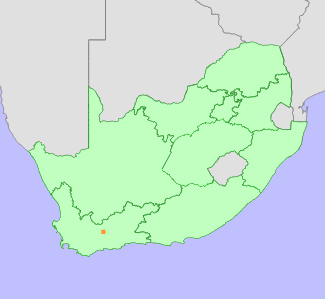|
Scientific Name | Tanquana hilmarii (L.Bolus) H.E.K.Hartmann & Liede |
Higher Classification | Dicotyledons |
Family | AIZOACEAE |
Synonyms | Pleiospilos hilmarii L.Bolus |
National Status |
Status and Criteria | Critically Endangered B1ab(ii,iii,iv,v)+2ab(ii,iii,iv,v) |
Assessment Date | 2022/05/23 |
Assessor(s) | J.H. Vlok, A.L. Schutte-Vlok, A. Lynch, D. Raimondo & N.N. Mhlongo |
Justification | This species is known from a single location and has an extent of occurrence (EOO) and an area of occupancy (AOO) of less than 4 km². It has experienced a significant decline in the past due to habitat loss resulting from groundwater extraction and illegal harvesting. Only one subpopulation remains, with fewer than 1000 mature individuals, which is threatened by trampling and the ongoing illegal collection of mature individuals for the specialist succulent trade. Therefore, it qualifies as Critically Endangered under criterion B. |
Distribution |
Endemism | South African endemic |
Provincial distribution | Western Cape |
Range | This Western Cape endemic is restricted to the Little Karoo, where it occurs south of Laingsburg. |
Habitat and Ecology |
Major system | Terrestrial |
Major habitats | Western Little Karoo |
Description | Plants are found in cracks between shale ridges in the succulent karoo. |
Threats |
| This species is highly sought after by succulent collectors, and it is widely represented in collections in the United Kingdom. One of the historical locations was lost to illegal collecting in the 1990s, and this threat is still ongoing. The loss of suitable habitat due to the construction of a borehole resulted in the decline of more than half of the total population in the past. Trampling is another major threat to this species, given that the plants are quite small and inconspicuous. |
Population |
This species was historically known to occur in three locations, but it is now currently known from only one subpopulation with approximately 1000 individuals. An entire subpopulation near Keurfontein was lost to illegal collection in the 1990s, while the construction of a borehole in one of the larger subpopulations resulted in the loss of almost 50% of the entire population. Although the remaining population is well-protected, it is situated close to a well-known road, making it vulnerable to illegal collection. Additionally, the plants are susceptible to trampling as they are difficult to see.
|
Population trend | Decreasing |
Assessment History |
Taxon assessed |
Status and Criteria |
Citation/Red List version | | Tanquana hilmarii (L.Bolus) H.E.K.Hartmann & Liede | CR B1ab(v)+2ab(v) | Raimondo et al. (2009) | | Tanquana hilmarii (L.Bolus) H.E.K.Hartmann & Liede | Rare | Hilton-Taylor (1996) | | Pleiospilos hilmarii L.Bolus | Endangered | Hall et al. (1980) | |
Bibliography |
Goldblatt, P. and Manning, J.C. 2000. Cape Plants: A conspectus of the Cape Flora of South Africa. Strelitzia 9. National Botanical Institute, Cape Town.
Hall, A.V., De Winter, M., De Winter, B. and Van Oosterhout, S.A.M. 1980. Threatened plants of southern Africa. South African National Scienctific Programmes Report 45. CSIR, Pretoria.
Hilton-Taylor, C. 1996. Red data list of southern African plants. Strelitzia 4. South African National Botanical Institute, Pretoria.
Raimondo, D., von Staden, L., Foden, W., Victor, J.E., Helme, N.A., Turner, R.C., Kamundi, D.A. and Manyama, P.A. 2009. Red List of South African Plants. Strelitzia 25. South African National Biodiversity Institute, Pretoria.
Vlok, J. and Schutte-Vlok, A.L. 2010. Plants of the Klein Karoo. Umdaus Press, Hatfield.
|
Citation |
| Vlok, J.H., Schutte-Vlok, A.L., Lynch, A., Raimondo, D. & Mhlongo, N.N. 2022. Tanquana hilmarii (L.Bolus) H.E.K.Hartmann & Liede. National Assessment: Red List of South African Plants version . Accessed on 2025/08/20 |
 Comment on this assessment
Comment on this assessment


